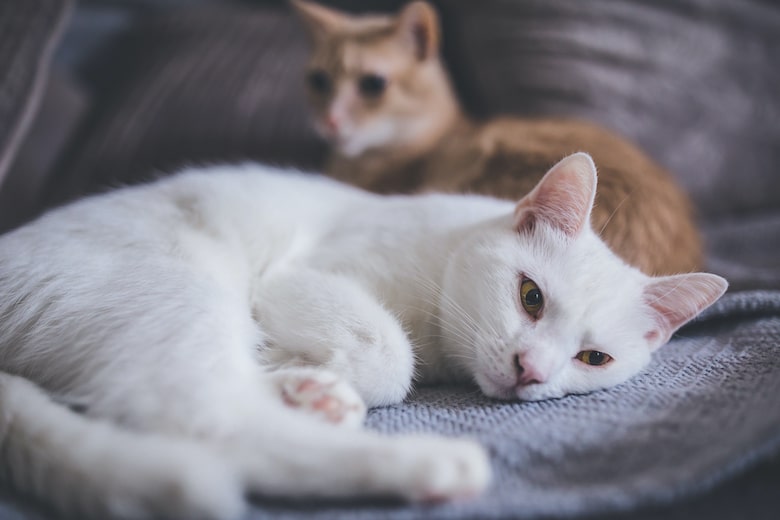Anyone who has ever shared a home with multiple cats has at one point or another experienced conflict between cats in the home. In some cases, squabbles are isolated or short-lived, but other times there are ongoing issues between cats.
“Cats are naturally quite territorial creatures and territorial aggression may develop if they feel an intruder has invaded their territory and they are competing for resources,” says Dr. Jamie Richardson, Medical Chief of Staff at Small Door Veterinary.
Signs of a territorial conflict between cats often take the form of “hissing, loud meowing, stalking, chasing, swatting or preventing the other cat from gaining access to places” explains Dr. Richardson.

Photo: Getty Images
How to reduce conflict between cats
While conflict between cats in the home might be natural, there are strategies you can use to reduce conflict and/or help your cats develop a more appropriate and less confrontational relationship with each other. Below are detailed step-by-step tips to help your cats feel more secure in their place in the home.
“Ensure each cat has their own territory and keep them separated temporarily. Provide a ‘safe space’ for each of your cats, where they can relax away from any stressors. A quiet, darkened place, made from cardboard boxes or sheets draped over chairs can work well. You may wish to keep each cat in a completely separate room if the conflict is severe. Make sure your cast can live in their own space comfortably for a few days, and provide all the essentials in this one room: food, water, bedding, a litter box, a scratching post and toys.
Related: How To Use An Amazon Box To Entertain Your Cat All Day Long
Slowly reintroduce each cat. Start with their scents – use a common towel, brush or other item between your pets to help them recognize and get used to each other’s scents. Then slowly allow them to spend time together. Gradually increase the duration of their interactions until they have adapted to living in the same space. Continue to introduce and separate your pets until they are coexisting safely.
Provide individual bowls, litter trays, toys and attention. Even after your cats are interacting well together, continue to ensure that they each have their own food and water bowls, their own litter trays, their own toys, scratching posts and perches. You should also spend plenty of time playing with and petting each cat, to ensure they don’t get jealous of the other.
Continue to feed cats separately: Being fed in direct visual contact of one another can result in fear and intimidation, and can discourage the “victim” cat from eating. Therefore, you will likely need to feed your cats in different rooms for a prolonged period of time (even after they are coexisting without conflict) so that no food aggression arises.
Use positive reinforcement to encourage good behavior. Whenever your cats display good, non-confrontational behavior toward each other, reward them with plenty of positive reinforcement – praise, pets and treats. This will help to cement the idea that good behavior brings good things and will encourage them to repeat that behavior.
Use pheromone sprays or diffusers. Pheromones are natural chemicals released by cats (as well as other animals and humans) in response to certain emotions or stimuli. Other cats can smell these pheromones and understand them as messages. For example, happy or relaxed cats will release positive pheromones, whereas an anxious or territorial cat may release correspondingly negative pheromones to warn other cats in the vicinity. Pheromone sprays and diffusers work by mimicking the positive, or “happy cat” pheromones, and can help to calm stressed or anxious cats by reassuring them that all is well in the nearby environment. You can use sprays on bedding, scratching posts and other common areas, and you can plug pheromone diffusers into wall outlets around your home and near the litter box.
Consider increasing the size of each cat’s territory by adding more vertical space. If you live in a smaller apartment and are worried your cats do not have enough individual space, there are a number of ways you can increase their territory vertically, such as cat trees, cat shelves and window perches (provided they are safe and there’s no chance the cat could fall out).
Provide places to hide throughout your cats’ territory. Ensure your cats have plenty of places to retreat to and hide if they feel anxious or threatened. Darkened places such as cardboard boxes and/or spaces draped with fabric work well.”
While conflict between cats isn’t unusual it can be a sign of a medical condition. Dr. Adam Miller, DVM, from the Internal Medicine team at NorthStar VETS says if you notice a shift in the relationships between cats, it’s a good time to bring your cats in for a veterinary appointment.
Read Next: How to Introduce Your Cat to a New Baby
